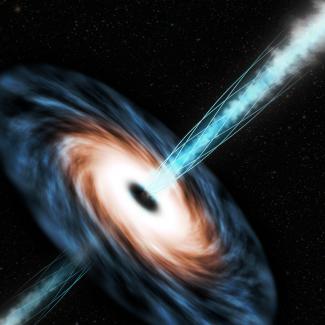Supermassive black holes at the center of active galaxies are known as blazars when they are extremely bright and produce powerful jets of matter and radiation visible along the line of sight to the Earth. Blazars can appear up to a thousand times more luminous than ordinary galaxies, and their associated jets are so powerful they can travel millions of light years across the Universe. Blazar jets produce flares of high-energy gamma rays that are detected by ground- and space-based observatories.
Locating the sites where gamma rays are produced in the jets, determining how fast they travel, and understanding how they are produced are important goals of many astrophysicists, including former research associate Krzysztof Nalewajko, Fellow Mitchell C. Begelman, and Visiting Fellow Marek Sikora of Poland’s Nicolaus Copernicus Astronomical Center.
Nalewajko and his colleagues recently analyzed data from actual gamma-ray flares gathered by the Fermi Gamma-Ray Space Telescope and applied three plausible physical constraints to estimate the distance from the black hole at which those flares are produced in the jets.
The first constraint was that the jet is narrow enough to allow it to respond to the rapid changes in its environment. The second constraint was that the jet is fast enough to suppress X-ray emission associated with any gamma-ray flares below the observed level. The third constraint was that the cooling of energetic electrons is fast enough to be consistent with the observed time scale.
Using these constraints, Nalewajko and his colleagues showed that gamma rays were most likely produced in jets at distances from a supermassive black hole ranging from 0.3 to 3 light years. This distance is actually quite close to the black hole, considering the millions of light years typically travelled by high-energy jets. The researchers were also able to use constraints to estimate the energy content and composition of the jets.
This analysis contradicts some estimates based on high-resolution radio observations that gamma rays can be produced at distances up to 30 light years. It also opens the door to new theoretical and observational studies of the three constraints upon which this work relies.—Julie Phillips




